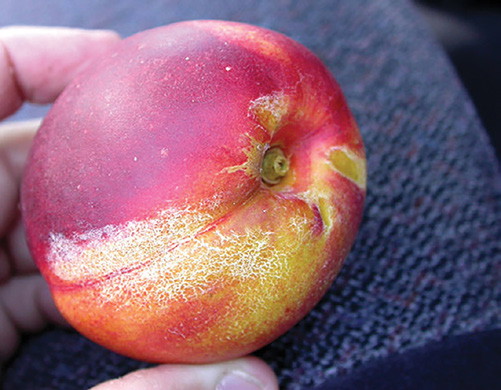New project:
Prevalence of Western Flower
Thrips in WA stone fruit

BY SUSAN CROSSLEY
VALUE CHAIN
FACILITATOR,
STONEFRUIT
Western Flower Thrips (WFT) and associated fruit damage have been a concern for some years in WA orchards. Of primary concern is the fact there are limited registered actives for WFT, which is leading to resistance of current insecticides used for their control.
DPIRD WFT Study and Management Strategies Review
The last work to determine the species of thrips present in the Perth Hills was done in the late 2000s. Therefore, the first step we are taking is collecting data to make sure we understand the problem. We will be working with the Department of Primary Industries and
Regional Development (DPIRD) during this upcoming season to determine the species of thrips present in the Perth Hills, the timing of their attack, and the nature of the damage caused.
Project objectives
The project with DPIRD will help us to understand:
• Are there changes in thrips behaviour?
• Are the same species causing damages to fruits?
• Has the timing of thrips management changed?
• Are there any new thrips species present and causing damage, such as chilli thrips?
Project outline
The project will consist of the following three aspects:
• Literature review: DPIRD will undertake a literature review with stone fruit growers, looking into management practices, WFT issues and potential future management opportunities.
• Grower online survey: This will help us determine the species present, level of damage, geographic spread of WFT as a pest, crops damage, current management strategies including monitoring, spraying and other techniques used.
• Field delimiting survey: DPIRD will undertake the following to determine species presence and abundance, measure degree, and determine critical crop stages for management:
— Conduct weekly sampling across one production season of nectarines on 3 growers’ properties in different areas within the Perth Hills
— Sampling methods will include inflorescence, bud tapping and trapping with TriPher lure and sticky traps
— Record phenology at each visit and photograph and measure fruit size once fruit is formed
— Record visual state of orchard management at each visit
— Once fruit has formed, undertake visual inspections of fruits for thrips damage, to see if we can quantify economic impact and types of damage caused by varying degrees of thrips populations.
We will keep growers updated on the progress of the project through our monthly newsletter and WA Grower magazine. A representative from DPIRD will present the full findings from the literature review, grower online survey and the field survey at next year’s AGM.
Determining the species of thrips, timing of their attack, and nature of the damage caused.

SILVERING damage on nectarine from Western Flower Thrips.
MORE INFORMATION
Contact Susan Crossley on 0474 550 424or at susan.crossley@perthnrm.com
Department of Primary Industries and Regional Development
